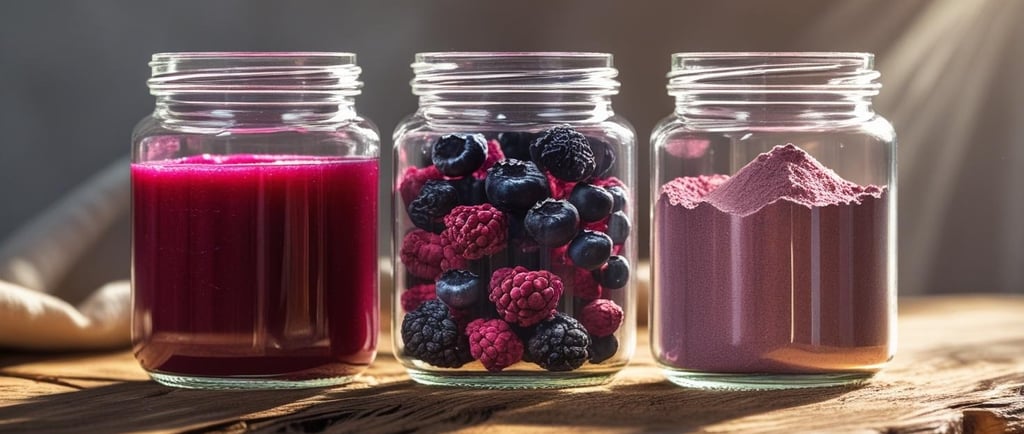Your Superfood Is Only as Good as Its Drying Method
Uncover the difference between cold-pressed, freeze-dried, and spray-dried ingredients, and why nutrient retention could make or break your clean-label product. Learn what method preserves the most nutrition, flavor, and function.


In the world of clean-label food, health claims come easy. “No additives,” “superfood-packed,” “as fresh as nature intended.” But here’s what rarely gets mentioned on-pack: how that fruit, veggie, or extract went from farm to shelf, and what was lost (or gained) in the process.
Whether it’s a powder, capsule, or drink, drying method matters. It doesn’t just affect color and shelf life, it decides whether your “vitamin C-rich” acerola powder actually contains any vitamin C by the time it hits your spoon.
Let’s break down the three most common methods, cold-pressing, freeze-drying, and spray-drying, and see what science has to say about nutrient retention, real-world stability, and functional performance.
Cold-Pressed: Fresh, Flashy, and Fleeting
Cold-pressed juice is beloved by wellness purists for a reason. It’s processed without heat, using hydraulic pressure to extract juice, oil, or plant compounds in their most raw form.
Nutrient retention? Incredibly high, at first. Vitamin C, polyphenols, and enzymes stay intact because there’s no heat to degrade them. But without pasteurization or stabilizers, cold-pressed juices oxidize quickly. Vitamin C drops by up to 50% within just a few days in storage.
Even worse? It’s not a drying method. Cold-pressed works for liquids, but if your end goal is a powder or shelf-stable product, this process won’t get you there.
Use case: Excellent for ultra-fresh juices. Not viable for powders or long-shelf-life formats.
Freeze-Dried: The Nutrient Time Capsule
Freeze-drying (aka lyophilization) is the gold standard for nutrient preservation. Foods are frozen, then placed under vacuum, allowing ice to vaporize without passing through a liquid phase. No boiling, no structural collapse, and very little nutrient loss.
In published studies:
Vitamin C retention ranges from 90–98% in freeze-dried fruits like strawberries, oranges, and papaya.
Polyphenol content remains largely intact, and antioxidant activity is consistently higher than in conventional drying methods.
Carotenoids and chlorophylls, found in leafy greens, hold their integrity far better than in heat-based drying.
The results are visually vibrant, structurally crisp, and nearly identical to the original. And because freeze-drying happens under low temperatures, even fragile compounds like folate and anthocyanins survive.
But here’s the rub: it’s slow, expensive, and energy-intensive. Not ideal for high-volume production unless you're selling premium.
Use case: Best for high-value powders, snacks, and supplements where nutrient retention and visual integrity matter.
Spray-Dried: The Underestimated Workhorse
Spray-drying sounds intense, liquid gets atomized into a chamber of hot air, instantly converting it to a fine powder. Temperatures can reach up to 200°C, so you’d expect a nutritional wasteland, right?
Not so fast.
While some heat-sensitive nutrients like vitamin C degrade (up to 25% loss), spray-drying has its own superpower: bioavailability.
In studies comparing freeze-dried and spray-dried spinach juice, the freeze-dried version retained more flavonoids. But spray-dried powders had up to 4x higher absorption potential in the digestive tract. Why? Heat breaks open plant cells, making certain compounds easier for the body to access.
And when spray-drying is paired with smart carriers, like inulin, maltodextrin, or whey protein isolate, antioxidants and vitamins are significantly better protected. One study found that spray-drying papaya with maltodextrin retained 86.5% of its vitamin C, compared to ~93% for freeze-drying, surprisingly close, at a fraction of the cost.
Another bonus? Spray-drying allows for customization of particle size, solubility, and mouthfeel, making it ideal for functional drinks, protein powders, and shelf-stable supplements.
Use case: Best for scalable nutrition with thoughtful formulation. Good retention, excellent absorption, fast turnaround.
Heat Isn’t Always the Enemy
It’s tempting to villainize heat in the name of “raw nutrition,” but not all nutrients behave the same under pressure.
Vitamin C is notoriously heat-sensitive. Freeze-drying wins here, hands down.
Carotenoids (like beta-carotene and lutein) are actually more bioavailable after light heating.
Polyphenols are stable across a range of methods, and in some cases, spray-drying increases their antioxidant activity.
The real question isn’t “how much of a nutrient survives,” but rather, how much your body can actually use.
The Carrier Effect: The Unsung Hero of Nutrient Stability
Carriers are typically invisible on labels (often tucked into “other ingredients”), but they make or break retention during drying.
Think of them like protective packaging for nutrients. When compounds like vitamin C or polyphenols are paired with carriers like gum arabic, starch, or protein isolates, their stability increases dramatically under heat. Carriers can also improve flowability, dispersibility, and shelf life.
In several trials, spray-dried powders with carriers retained 80–95% of antioxidant capacity, closely rivaling freeze-dried versions. It’s not just about method—formulation matters.
So, Which Method Wins?
That depends on what you’re solving for:
Maximum retention? Freeze-drying is your best bet, if you can justify the cost.
Maximum absorption? Spray-drying often gets nutrients to the finish line more efficiently.
Maximum freshness? Cold-press is unbeatable, if consumed immediately.
There’s no universal winner, just different tools for different product goals. Think of drying methods like cooking techniques: steaming, roasting, and grilling all bring something different to the table.
Final Thought: It’s Not About Perfection, It’s About Fit
In the clean-label world, we talk a lot about ingredients, but not enough about process. Yet how something is dried can impact everything from price to performance to nutrition.
Freeze-dried isn’t automatically better. Spray-dried isn’t automatically worse. And cold-pressed isn’t a catch-all. It’s the interaction between method, carrier, and compound that determines nutritional performance.
Whether you’re scanning a label or formulating something new, ask the deeper question: what nutrients do I want, and how will they get where they need to go?
Because the best health products aren’t just well-sourced, they’re well-processed.
Ready to retain more than just claims? Let’s talk process.
